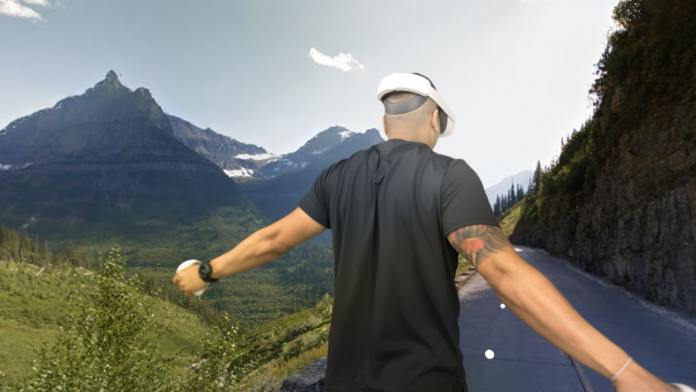Until now VZFit has been an exercise service solely for use with a stationary bike. Split into two separate apps, VZFit Play is a suite of arcade minigames in which pedaling becomes your form of locomotion through immersive computer-generated environments. Using an Oculus Touch controller, or a third-party compatible control button you can play simple, but fun games like shooting tanks, flying helicopters, racing a Formula One car, etc. The idea is that you can experience a cycle workout as a side effect to playing games and it works well. Check out my full VZFit Play review for all the details on that app.
The second app that you receive as part of the VZFit package is VZFit Explorer. This offers full, immersive integration of Google Street View imagery, allowing you to quite literally cycle the world in virtual reality. Check out my full VZFit Explorer review for much more detail on this excellent fitness app.
Over the past year Explorer especially has captured the imagination of a growing number of VR fitness users, who have been using the app to create their own routes. Tackling everything from scenic jaunts around favorite holiday destinations, nostalgic visits to old neighborhoods, to epic transcontinental adventures that take many months to complete, Explorer offers the kind of expansiveness and scale that only something like Microsoft Flight Simulator can hope to match.
For me, it’s one of the greatest apps available in VR, and a long-term fitness essential.
Both VZFit Play and VZFit Explorer have been exclusively available on the Oculus Quest platform for well over a year, but because usage required both an indoor bike and a Bluetooth cadence sensor to work with the Quest, the app was required to be hidden.
The reason for VZFit’s now official Quest launch is Virzoom’s introduction of an all-new standalone Explorer mode, that no longer requires a stationary bike. The review that follows will focus entirely on the exerboard mode but note that both bike apps VZFit Play and Explorer are still part of the new product launch, and you will get access to all three.
Introducing The Exerboard – Fitness Through Exploration
In decoupling the Explorer app from the need to own a stationary bike, Virzoom has introduced a completely new kind of full-body workout. Beat Saber perfected the musical rhythm-based genre, whilst FitXR and Thrill of The Fight allow users to get their exercise fix through boxing. Other popular VR fitness genres include sword and weapons fighting, ball sports, and archery. What we haven’t had before is fitness through exploration.
Virzoom has taken its Explorer app and added a virtual ‘Exerboard’, a strange device part tricycle, part hoverboard that emits a hum like a UFO. Standing upon its circular platform you propel the vehicle through your own body movements. Specifically, it’s your headset and controllers that are tracked. Therefore the faster you move your head and hands the faster the exerboard will travel.
As with cycling you can choose from any of the preset routes, or create your own. Have you ever fancied walking, or jogging, or maybe squatting your way across your county or state? Well, now you can…
It takes a little getting used to and it can feel a little obtuse at first. Cycling is easy of course, you pedal and go, but working out how to best move your body to move the exerboard is a little more esoteric.
Trainers put you through a guided workout
Thankfully, Virzoom has anticipated this and provides a handy trainer to travel in front of you and who will guide you through a series of bodyweight exercises. Upon using VZfit for the first time you will be taken through a comprehensive tutorial that will get you up and running. I’ve recorded footage of the tutorial below that will give you a clearer idea of how it works.
According to Virzoom, each workout pulls exercises from a database of 55 body movements in total so there is some variety to be found. They focus on working the entire body, with plenty of squats, lunges, and knee raises. Because the Quest only tracks the headset and controllers, certain exercises involving leg and knee raises don’t get recognized as movement and the exerboard will slow right down, whilst you complete them. I did find this stop-start nature a little disjointed at times, as I like to see the scenery fly by at a constant rate but you aren’t obliged to follow the instructor if you don’t want to, or even have a trainer at all.
Commercial music, modern hits, and classics
VZFit has various radio stations offering modern pop, classics hits, and electronic music so if you’re someone who likes to dance you can groove your way through cities and towns if you desire. Standing on the exerboard brought back memories from my youth of taking part in a town carnival, reluctantly dancing on a float as the procession made its way through the town center.
Play it your way
Shadowboxing works well for movement and I worked out a few routines of my own. As the headset is tracked, fast squats combined with arm raises will accelerate the craft to full speed, so I liked to adopt a kind of ski erg movement, starting with my hands raised above my head then squatting down bringing my hands toward the floor, then back up, hands raised and repeat. I’d do about fifteen fast reps then switch to a minute of swinging my arms side to side as if I was sprint speed skating, which is awesome fun, especially on downhill routes. The strength of VZFit Explorer is that you can go anywhere, so speed skating down mountains is easy to set up and a great way to burn some calories!
The beauty of the exerboard is that the choice is entirely up to you. I’d recommend starting with the trainer for some structured coaching, but feel free to experiment with what works for you, and choose your routes accordingly.
So that’s an overview of how the exerboard works, let’s commence the playtest.
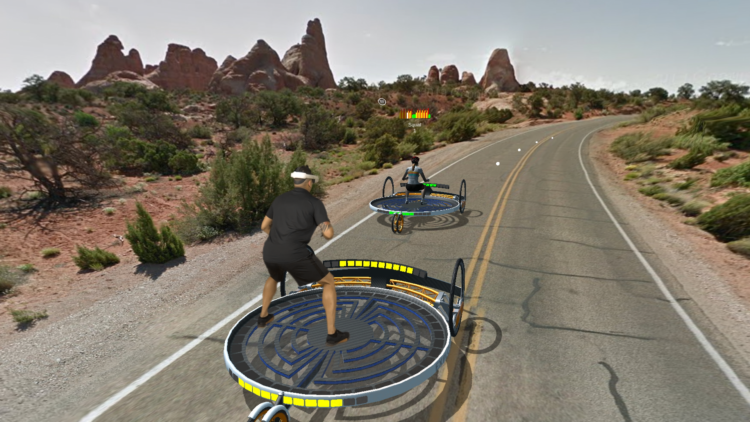
Preparation
If you intend to follow the trainer-led workouts clearing your playspace is an essential prerequisite. Despite being a forward-facing experience there is a lot of side-to-side movement, including left and right sidekicks. So don’t play this next to a wall or tables. Of course, if you are space limited it’s not a problem, you can stick to dancing, shadowboxing, or trying the ski erg and speed skating style movements I suggested.
Always wear a headband to keep the sweat out of your headset, and we also strongly recommend either a silicone cover to put over your Quest foam interface, or a replacement interface and cover. VRCover is my pick and they have a huge range to choose from.
To record my heart rate and fitness stats I used my now archaic but still reliable Fitbit Charge 2. For the fitness test session, I stuck to following the trainer-led moves.
Note that the following scores are for the Exerboard mode only, not the cycle modes which are reviewed elsewhere.
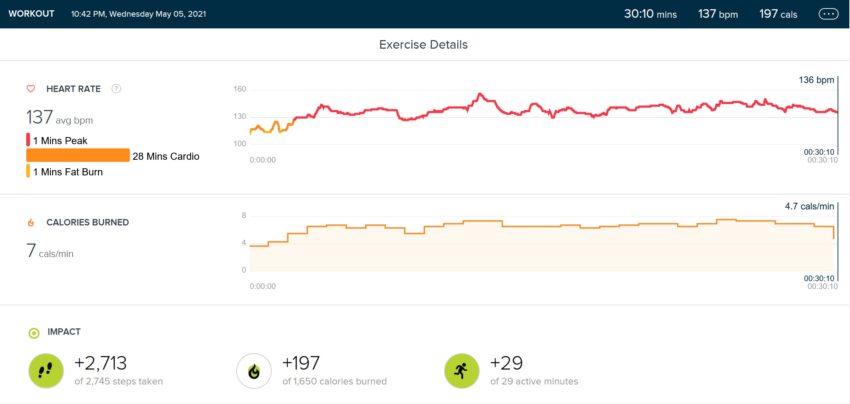
- Calories burned: 197
- Calories per minute: 7
- Average heart rate: 137
- Max heart rate: 156
- Steps:2713
- Active Minutes: 29 mins, 28 mins cardio, 1 min peak
Intensity 8/10
This score is based on following the instructor-led workouts, a mix of upper and lower body exercises, the kinds of which you’d see featured in a typical home workout video DVD. Working out using my own Ski Erg/Speed Racing style was definitely a 9 so there’s plenty of potential to increase the intensity if you desire.
Arms 7/10
During a typical session, the trainer will mix a variety of arm raises and uppercut moves into the workout, but the focus is more on getting the heart rate going than throwing power punches as opposed to something like FitXR. That said, as controller tracking is the primary means of locomotion, the faster you move your arms the faster you will travel so if you like to zip along at speed you are incentivized to swing your arms with gusto.
Legs 8/10
Although the Quest doesn’t have leg or foot tracking, the fact that your headset is tracked means vertical movement, as you get from squatting down and returning to full height is a fast and effective way to propel yourself along. Fast squats get you moving, and the trainer employs this liberally throughout the workouts. If you’re overweight or out of condition, or have bad knees you might struggle to execute all the squats, knee raises, and lunges in a thirty-minute workout so take it easy at first. The trainer is there as a guide, there’s no penalty for not executing all the squats that your trainer sets for you, so feel free to pace yourself. In terms of intensity, if you fully engage in all the leg exercises provided, I’d rate this as a harder leg workout than FitXR or Beat Saber, but well below the intensity of Holopoint, which is undoubtedly the leg crushing king.
Core and Balance 9/10
This is an excellent title for working on core strength and balance. Instructor-led twisting leg raises and sidekicks will work your obliques in a way not experienced in other VR games, whilst squats, lunges, and punching all require you to activate your core stabilizing muscles.
Time Perception 8/10
Unlike cycling, which is probably the most natural and instinctive way to locomote yourself through Explorer’s 3D realization of Google Streetview, the exerboard can feel a little confusing at first. How much you enjoy the experience will depend on how well you’re able to find a comfortable and fluid way to travel. With cycling, which I’d rate an easy 9, I can zone out to the music and enjoy the passing scenery whilst in an almost meditative state of non-conscious thought. On the exerboard, it’s harder for me to get into a flow state. Certain exercises such as knee raises, by virtue of them requiring minimal hand and head movement, will bring the exerboard to a crawl, and this somewhat disjointed stop-start motion would pull me out of the experience slightly. That said, if you’re somebody who has a natural body fluidity, and can enjoy dancing or shadowboxing for long periods, you might well find it easier to get into a steady rhythm than I did. After cycling Explorer for well over a year now, traveling on foot as it were, left me feeling a bit like a cowboy who had lost his horse. How much that is due to the exerboard, or to me being conditioned to want to cycle through Explorer through months of repetitive use I couldn’t say.
Replayability 10/10
The Explorer app features the entirety of Google Streetview to travel through, literally millions of miles of roads. If you enjoy the trainer-led workout structure or find your own appealing way of propelling this strange craft, then you can enjoy it knowing that you will never run out of new places to visit, or exotic lands to explore.
Virzoom also encourages consistent use through a variety of rewards and competitions. There are leaderboards, weekly events, achievements, and the ability to earn coins to buy new apparel for your avatar. You’ll even receive a weekly email telling you what you accomplished that week.
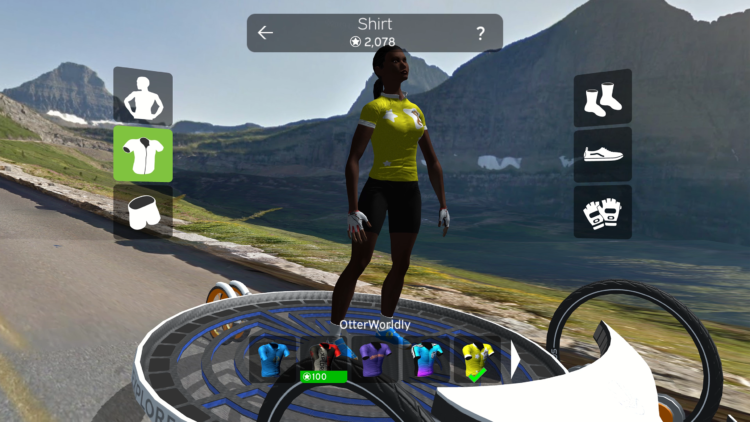
Fitness Scalability 9/10
Whilst you can follow the trainer-led workouts for consistent workout intensity, you are free to come up with your own movements and make the experience as easy or intense as you like. If you just want to gently walk on the spot whilst exploring your next intended holiday destination you can. If you want to simulate a lightning-fast speed skate downhill descent, then select your preferred mountaintop and pump those arms, and race to the bottom. You could even strap on a weighted vest, and some wrist and ankle weights to simulate a tough army-style hill march. Thanks to virtual reality’s ability to truly immerse you into the environments you can easily find a route to match your workout style and intensity.
Lack of Nausea 6/10
As a VR veteran of almost five years, I rarely, if ever experience nausea, and I never did here either. That said, I’m trying to put myself in the perspective of a beginner and I believe this could be a fitness app that might prove uncomfortable for those who don’t have their full VR legs just yet. You stand on a moving platform for one, which, if you’ve selected manual control, you steer by tilting your head. Whilst not making me feel sick, manual steering felt very awkward to me, and I can see some people having balance and motion sickness issues for sure. Virzoom does allow for automatic steering, for an on-rails type ride, which was definitely my preferred way to play. However, with auto-steering enabled, you can’t decide your own routes on the fly, and one of my favorite things to do when cycling VZFit Explorer is to set up a starting location but leave the destination empty, meaning I can just turn down whatever roads and side streets I choose as I ride along. I attempted the same on the exerboard starting from my house, but I found it impossible to turn onto certain streets, and standing and turning by tilting my head felt downright weird. As the standalone mode is brand new, I’m sure Virzoom will improve this shortly, but right now it’s not as comfortable as the cycle mode is. It also makes it hard to enjoy what I believe could be one of the most popular uses of this standalone mode, town, and city walking. Being able to visit locations and simply walk around at will in a fully 3D, moving version of Google Streetview is great, but not completely achievable at present with the current control method.
Social Competition 8/10
Over the past year, the VZfit community has really started to grow. The VZFit Community Group on Facebook is friendly and active with many community members creating, uploading, and sharing new rides. There are weekly and monthly challenges, alongside much larger seasonal challenges, that might consist of multiple rides and several hundred miles of roads. I previously recorded one such event I participated in, which remains one of my favorite VR events I’ve ever done. Although I personally prefer to cycle alone, there is a multiplayer function and you can ride with other users, either by bike or exerboard, and talk whilst you travel and explore the sights together.
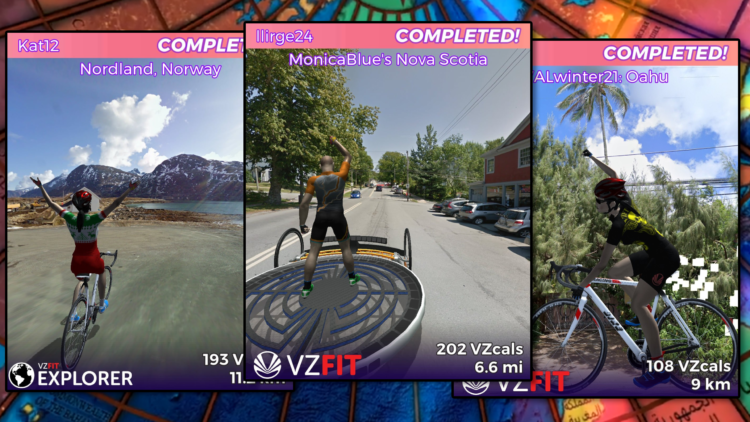
VZFit Exerboard Score 8/10 (VZFit Overall Package 9.5/10)
The standalone exerboard mode brings VZFit’s Explorer app and Google Streetview exploration to all Quest users without the need for a stationary bike. If achieving fitness through exploration appeals to you then this is definitely a great way to do it. Whilst the exerboard doesn’t replace the bike, it does offer very different workout possibilities so even long-time cycle Explorers like myself can benefit courtesy of both the well-structured trainer-led workouts and the ability to simulate walking, running, or skiing with a little imagination.
I would regard the exerboard as a complement to the original cycling mode, as opposed to a complete alternative, and I’d urge all users who do download and enjoy this mode to consider also buying a stationary bike and a Bluetooth cadence sensor if you don’t already have one. VZFit is a monthly subscription service, and you’ll get far better value, and greater workout variety if you can use all three VZFit apps and take advantage of what I believe to be the best indoor cycling app ever invented.
The Good
A new genre for VR fitness, exploring the great outdoors from the comfort of your own home is fun and effective exercise.
Effective trainer-led workouts work the whole body, and you can also make up your own.
Having access to real commercial music via the included radio stations creates a great workout mood and atmosphere.
Regular monthly updates offer gameplay and UI improvements, new content, and fixes. Virzoom is very responsive to community feedback and engages in open dialogue with members meaning users really can have an impact on VZFit’s direction and development.
The Bad
The exerboard doesn’t replace the bike and I’d still recommend one strongly for the complete VZFit experience.
Manual steering is very awkward.
Explorer visuals can sometimes distort, which I’ll cover in detail below.
Note on Explorer visuals and addressing some negative user reviews.
Finally, I wanted to address a fairly common observation from new users, which is that Explorer’s street view imagery can often look warped. Converting static photographs into moving three-dimensional environments can leave some scenes looking a little wonky in places. This is an inevitable limitation of current technology rather than poor programming, the same way that photogrammetry cities in Microsoft Flight Simulator can look melted near ground level. Some negative user reviews have suggested the app is either in beta or poorly produced due to these visual artifacts. I can assure you this isn’t the case. Virzoom is an extremely capable development team. Programming lead and co-founder Eric Malefeew is a twenty-year veteran of the video game industry and an expert on integrating peripherals into computer games and simulations. As a lead programmer for Harmonix, he worked on Guitar Hero, Rock Band, and Dance Central, has coded cockpit simulations for Lockheed Martin, and was also involved in research relating to sensor integration and control systems for Lunar and Mars prototype rovers on NASA grants.
From a year’s personal experience of using VZFit Explorer, I can tell you your eyes and brain quickly adapt, and what may seem jarring at first, will become less noticeable as you ride more often. If part of the view corrupts for me, I’ll just stare at the road, or my bike/exerboard, or my training partner ahead of me until it clears.
The problem is worse in heavily built-up areas like town centers and you can minimize the distortion problem by selecting routes that contain wide open spaces, moorland, desert, and countryside routes.
It’s not all bad either. There are some scenes, especially when traveling next to a cliff wall or down a country lane with consistent trees and hedgerows where the 3-D effect is truly palpable, eliciting a sense of presence that could only feel more real by physically being there.
Much like Microsoft Flight Simulator, I find that for every strange visual quirk I encounter, I’ll also experience a breathtaking moment where my sense of immersion is so strong my brain remembers it as a real memory.
Give VZFit a chance and your persistence will likely see your first impressions change. It’s an incredible app.
VZFit – How To Access
VZFit is available now on the Oculus Quest store. This is a subscription service that you download for a free seven-day trial. Upon completion of the trial, you can either stay a premium member for $9.99 a month or default to a restricted free version consisting of the Colorado Springs route, along with one other Explore route, which changes on a monthly basis, and one VZFit Play game, which also changes monthly. Multiple family members can set up their own profiles on the same account so entire households can enjoy VZFit on a single subscription.

